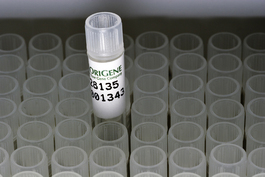PIP5K3 (PIKFYVE) (NM_152671) Human Untagged Clone
CAT#: SC313536
PIKFYVE (untagged)-Human phosphoinositide kinase, FYVE finger containing (PIKFYVE), transcript variant 3
"NM_152671" in other vectors (4)
Product Images

Specifications
| Product Data | |
| Type | Human Untagged Clone |
| Tag | Tag Free |
| Symbol | PIKFYVE |
| Synonyms | CFD; FAB1; HEL37; PIP5K; PIP5K3; ZFYVE29 |
| Vector | pCMV6-Entry |
| E. coli Selection | Kanamycin (25 ug/mL) |
| Mammalian Cell Selection | Neomycin |
| Sequence Data |
>NCBI ORF sequence for NM_152671, the custom clone sequence may differ by one or more nucleotides
ATGGCCACAGATGATAAGACGTCCCCAACACTGGACTCTGCTAATGATTTGCCTCGATCTCCTACTAGTC CTTCTCATCTCACACACTTTAAACCTTTGACTCCTGATCAAGATGAGCCCCCTTTTAAATCAGCTTATAG TTCTTTTGTAAATCTCTTTCGTTTTAACAAAGAGAGAGCAGAAGGAGGCCAGGGAGAACAGCAGCCTTTG AGTGGAAGTTGGACCAGCCCTCAGCTCCCTTCGAGGACACAGTCTGTTAGGTCACCCACACCTTATAAAA AGCAGCTTAATGAGGAACTCCAGCGGCGCTCTTCAGCATTAGGAGACCTCCGAGCTTGCACATATTGTAG AAAAATAGCCTTAAGTTATGCTCATTCCACAGACAGTAATTCTATTGGGGAAGACTTGAATGCTCTTTCA GATTCTGCTTGCTCTGTGTCTGTGCTTGATCCAAGTGAACCCCGAACACCTGTTGGGAGTAGGAAAGCCA GCCGTAACATATTTTTAGAGGATGATTTGGCCTGGCAAAGTTTGATTCATCCAGATTCCTCAAATACTCC TCTTTCAACAAGACTTGTATCTGTGCAAGAGGATGCTGGGAAATCTCCTGCTCGAAATAGATCAGCCAGC ATTACTAACCTGTCACTGGATAGATCTGGTTCTCCTATGGTACCTTCATATGAGACATCTGTCAGTCCCC AGGCTAACCGAACATATGTTAGGACAGAGACCACTGAGGATGAACGCAAAATTCTTCTGGACAGTGTGCA GTTAAAAGACCTGTGGAAAAAAATCTGCCATCACAGCAGTGGAATGGAGTTTCAGGATCACCGCTACTGG TTGAGAACGCATCCCAACTGCATTGTAGGAAAGGAATTAGTCAACTGGCTAATCCGAAATGGGCATATTG CCACAAGGGCACAAGCTATAGCAATTGGACAAGCAATGGTTGATGGACGTTGGCTGGATTGTGTTAGTCA TCACGACCAGCTTTTCAGAGATGAGTATGCGCTGTATAGACCACTGCAGAGTACAGAATTTTCTGAGACG CCTTCTCCCGACAGTGACTCAGTGAACTCCGTGGAAGGACACTCTGAGCCATCCTGGTTTAAAGACATAA AGTTTGATGACAGTGACACAGAACAGATAGCTGAAGAAGGTGACGATAATTTGGCTAATTCTGCCAGTCC TAGCAAGCGCACATCAGTCAGCAGTTTCCAGTCCACAGTGGACAGTGACTCAGCCGCTTCTATCAGCCTG AACGTGGAGCTGGACAACGTGAACTTCCATATCAAGAAGCCCTCCAAGTACCCACATGTGCCCCCTCACC CTGCTGACCAAAAAGGTAGGAGGTAG |
| Restriction Sites | SgfI-MluI |
| ACCN | NM_152671 |
| ORF Size | 1356 bp |
| OTI Disclaimer | Our molecular clone sequence data has been matched to the reference identifier above as a point of reference. Note that the complete sequence of our molecular clones may differ from the sequence published for this corresponding reference, e.g., by representing an alternative RNA splicing form or single nucleotide polymorphism (SNP). |
| OTI Annotation | This TrueClone is provided through our Custom Cloning Process that includes sub-cloning into OriGene's pCMV6 vector and full sequencing to provide a non-variant match to the expected reference without frameshifts, and is delivered as lyophilized plasmid DNA. |
| Reference Data | |
| RefSeq | NM_152671.3, NP_689884.1 |
| RefSeq Size | 2130 |
| RefSeq ORF | 1356 |
| Locus ID | 200576 |
| Domains | DEP |
| Protein Families | Druggable Genome |
| Protein Pathways | Endocytosis, Fc gamma R-mediated phagocytosis, Inositol phosphate metabolism, Metabolic pathways, Phosphatidylinositol signaling system, Regulation of actin cytoskeleton |
| Gene Summary | Phosphorylated derivatives of phosphatidylinositol (PtdIns) regulate cytoskeletal functions, membrane trafficking, and receptor signaling by recruiting protein complexes to cell- and endosomal-membranes. Humans have multiple PtdIns proteins that differ by the degree and position of phosphorylation of the inositol ring. This gene encodes an enzyme (PIKfyve; also known as phosphatidylinositol-3-phosphate 5-kinase type III or PIPKIII) that phosphorylates the D-5 position in PtdIns and phosphatidylinositol-3-phosphate (PtdIns3P) to make PtdIns5P and PtdIns(3,5)biphosphate. The D-5 position also can be phosphorylated by type I PtdIns4P-5-kinases (PIP5Ks) that are encoded by distinct genes and preferentially phosphorylate D-4 phosphorylated PtdIns. In contrast, PIKfyve preferentially phosphorylates D-3 phosphorylated PtdIns. In addition to being a lipid kinase, PIKfyve also has protein kinase activity. PIKfyve regulates endomembrane homeostasis and plays a role in the biogenesis of endosome carrier vesicles from early endosomes. Mutations in this gene cause corneal fleck dystrophy (CFD); an autosomal dominant disorder characterized by numerous small white flecks present in all layers of the corneal stroma. Histologically, these flecks appear to be keratocytes distended with lipid and mucopolysaccharide filled intracytoplasmic vacuoles. Alternative splicing results in multiple transcript variants encoding distinct isoforms. [provided by RefSeq, May 2010] Transcript Variant: This variant (3) lacks two in-frame exons in the 5' coding region and all of the 3' coding region and UTR, compared to variant 2. The encoded protein (isoform 3) has a shorter N-terminus and a short novel C-terminus, compared to isoform 2. |
Documents
| Product Manuals |
| FAQs |
| SDS |
Resources
Other Versions
| SKU | Description | Size | Price |
|---|---|---|---|
| RC212288 | PIKFYVE (Myc-DDK-tagged)-Human phosphoinositide kinase, FYVE finger containing (PIKFYVE), transcript variant 3 |
USD 420.00 |
|
| RG212288 | PIKFYVE (GFP-tagged) - Human phosphoinositide kinase, FYVE finger containing (PIKFYVE), transcript variant 3 |
USD 460.00 |
|
| RC212288L3 | Lenti ORF clone of Human phosphoinositide kinase, FYVE finger containing (PIKFYVE), transcript variant 3, Myc-DDK-tagged |
USD 620.00 |
|
| RC212288L4 | Lenti ORF clone of Human phosphoinositide kinase, FYVE finger containing (PIKFYVE), transcript variant 3, mGFP tagged |
USD 620.00 |
{0} Product Review(s)
Be the first one to submit a review






























































































































































































































































 Germany
Germany
 Japan
Japan
 United Kingdom
United Kingdom
 China
China
